Once again about capsule locks
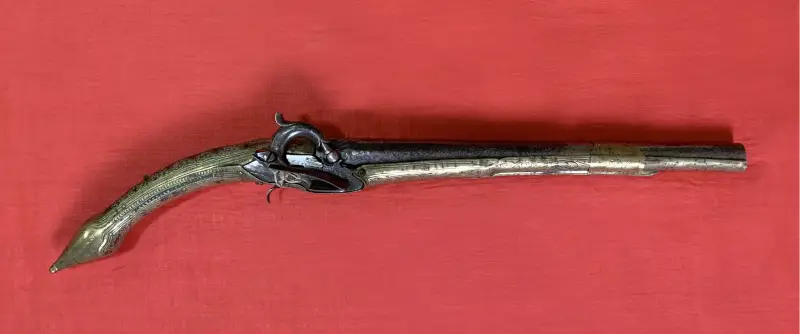
The pistol is an oriental capsule pistol, most likely made in the Balkans in the first half of the 19th century. Externally - completely archaic and characteristic of the Balkan weapons production of weapon parts from brass. A massive, protruding trigger spring, which is typical for a “michelet” type lock. But... it already has a cap trigger. That is, we have a clear conversion of a flintlock pistol into a percussion pistol. Penza Regional Museum of Local Lore. Photo by the author
hunger and death -
all this is created for revenge.Book of Wisdom of Jesus,
Son of Sirach, 39:36
History weapons. Having learned the power of gunpowder, people immediately thought of how to use it to their own detriment, but they did not immediately figure out how to set fire to it inside the barrel. Although... the same flint has been known since the early Iron Age. Hot iron rods, which required a brazier with coals, a wick made of hemp rope soaked in a solution of saltpeter, and finally spark locks, designed like a lighter with a wheel or a simple impact flint - these were the stages in the development of the gunpowder ignition system in the barrel of a firearm. And chemistry did not play any role in this until 1799!
And this year, mercury fulminate or fulminate of mercury in its pure form was obtained by the British chemist Edward Howard (discovered back in 1774 by the physician of the French royal court, Pierre Boyen) and, as very often happened, completely by accident. He reported his discovery to the Royal Society of London and... received a medal for it.
Howard's article on this discovery was published in the January 1800 issue of the journal Philosophical Transactions of the Royal Society of London. Moreover, it already reported on Howard’s experiments at the Woolwich Arsenal together with artillery inspector and superintendent of the Royal Foundries, Colonel Thomas Blomfeld and professor of chemistry at the Royal Military Academy, William Cruickshank. It was assumed that the new substance could be used instead of gunpowder.
It should be noted that the end of the 1786th century was truly marked by the invention of a wide variety of “explosives.” Thus, the French chemist Claude Louis Berthollet, working on the synthesis of salts of hypochlorous and hypochlorous acids, managed to obtain potassium chlorate (Berthollet's salt) in 1788, and in XNUMX another very strong, albeit expensive, explosive - silver nitride (Berthollet's fulminate). ). So Howard's discovery simply dotted the i's for that period of time.
However, all this was more than enough for Alexander John Forsyth to use the explosive properties of mercury fulminate to ignite a powder charge in a gun table in 1805. That is, he decided to do without wheel and impact locks. And already on April 11, 1807, he received a patent for his invention, and then designed a new type of castle, which led to another revolution in military affairs.

Diagram of the Forsyth "bottle lock" device: images from left to right:
1 – the central cylinder with a hole going into the barrel is motionless; 2 – the bottle is turned, the lid of the container with mercury fulminate powder is open; 3 – powder is poured into it; 4 – when the bottle is turned, the spring-loaded firing pin is above the ignition hole.
Fig. A. Shepsa
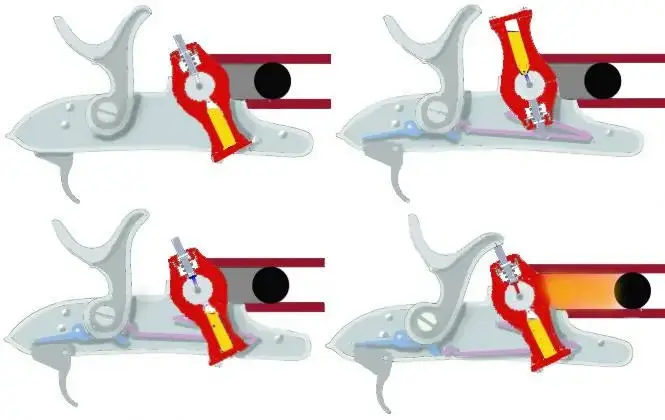
The scheme of the Forsyth's "bottle lock": images from left to right:
1 – position before the shot: gunpowder and bullet are in the barrel; 2 – the bottle is turned and explosive powder is poured into the pilot hole; 3 – the bottle turns again, and now the firing pin is above the ignition hole with a charge of powder; 4 – the trigger hits the firing pin, the powder ignites, the flame enters the barrel, and a shot follows!
Fig. A. Shepsa
The castle invented by Forsythe was called “chemical”, and it is clear why this is so, instead of flint and steel, “chemistry” worked in it. The inventor himself called it “explosive,” but the name “bottle” suited him best, since its main part was indeed... a bottle, similar to a small perfume bottle. It was fixed on an axis, inside of which the ignition hole of the barrel was located.
In order for the lock to work, it was first necessary to pour mercury fulminate powder into it! The lock turned, a hole opened in it, and this powder poured into the hole of the axle. Then the bottle had to be turned in the opposite direction. At the same time, there was another hole opposite the powder poured into it, through which it was struck by a long spring-loaded firing pin, which in turn was struck by the trigger. The impact ignited the mercury fulminate and ignited the gunpowder in the barrel!
The system worked, since 1809 Forsythe even began to produce guns with his own lock, but he failed to create demand for them.
Naturally, such a discovery could not help but attract the attention of many inventors who wished to improve Forsythe’s invention. And the main thing is that it was easy to improve, which opened up great prospects for creativity!
Instead of powder, for example, they began to use balls made from a mixture of fulminate of mercury with wax or resin. They also came up with a tape made of copper foil, inside which an explosive mixture was pressed and which, when cocked, was automatically applied to the ignition fire tube socket.
But, perhaps most of all, Forsyth’s epigones did not like the proximity of the container with mercury fulminate powder to the ignition hole of the barrel and the firing pin on which the trigger was hit.
“We should move all this away from the hole,” a certain Brute decided and came up with his own lock, also with a flammable mixture dispenser. In this lock, a container with mercury fulminate powder slid along a bar on the barrel, while the trigger itself pushed it, moving it away from the ignition hole in the same bar, into which, whenever the holes on them coincided, a certain amount of powder spilled out of the container!
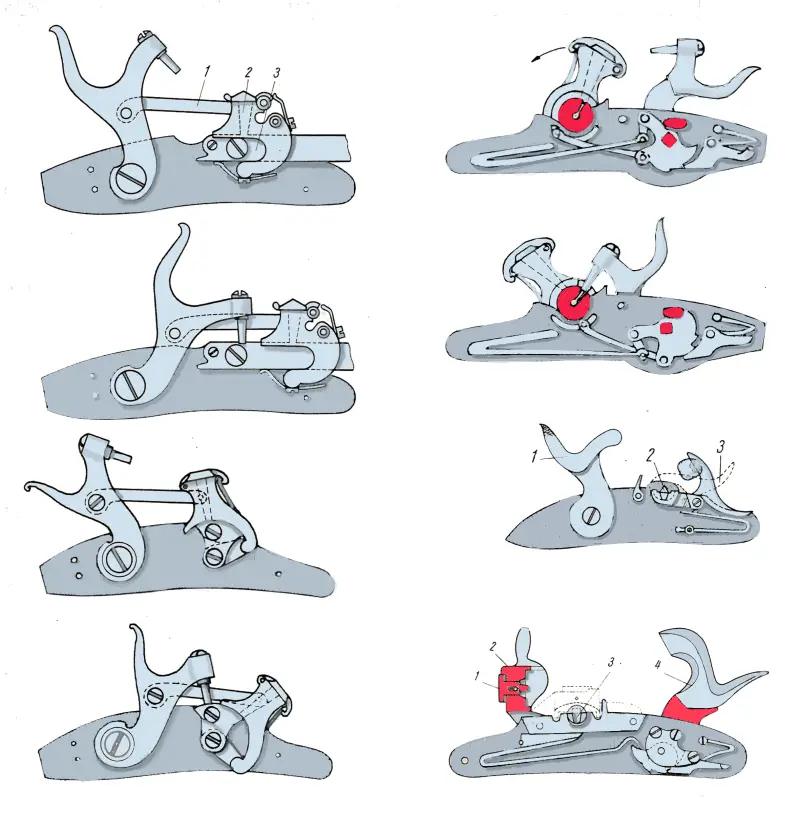
Different types of percussion cap locks, from left to right:
1, 2 – Bute “horizontal lock”: 1 – traction connecting the trigger with the container for explosive powder; 2 – container for explosive powder; 3 – guide bar for a container with explosive powder; 3, 4 – Kontriner rotary lock: in it the dispenser container was moved by the trigger not in a straight line, but in a semicircle; 5, 6 – diagram of the structure of the G. Koll lock; 7 – Console capsule lock, model 1838: 1 – trigger, 2 – tray for placing the capsule, 3 – safety cover; 8 – Augustine capsule lock. It had a slot for capsules (3), which was covered on top with a lid (2) with an anvil (1). The trigger (4) hit exactly this anvil!
Why such a complication is completely unclear, but it is clear that the capsule was protected very well from extraneous influences.
Very soon, namely in 1814, the American Joshua Shaw came up with the idea of filling caps with explosive compounds, first made of iron and then of copper foil. Around the same time, between 1814 and 1816, British gunsmiths Joseph Menton and Joseph Egg also came up with copper caps that fit on the ignition tube, and it was this lock that became widely known as the capsule lock.
However, the blow of the trigger on the primer often caused it to rupture, and its fragments hit the shooter in the face. Therefore, it is not surprising that lock designs immediately appeared that eliminated this drawback. So, for example, the Console lock had a special tray with a conical tip for puncturing the capsule and also a safety cover!
That is, the trigger did not hit the primer itself, but the cover that covered it, so that if it ruptured, all its fragments remained inside. The Augustine capsule lock received a similar device.
The gunsmith Potte also came up with a very original capsule lock system. His trigger, which struck the primer, was a curved trigger guard plate.
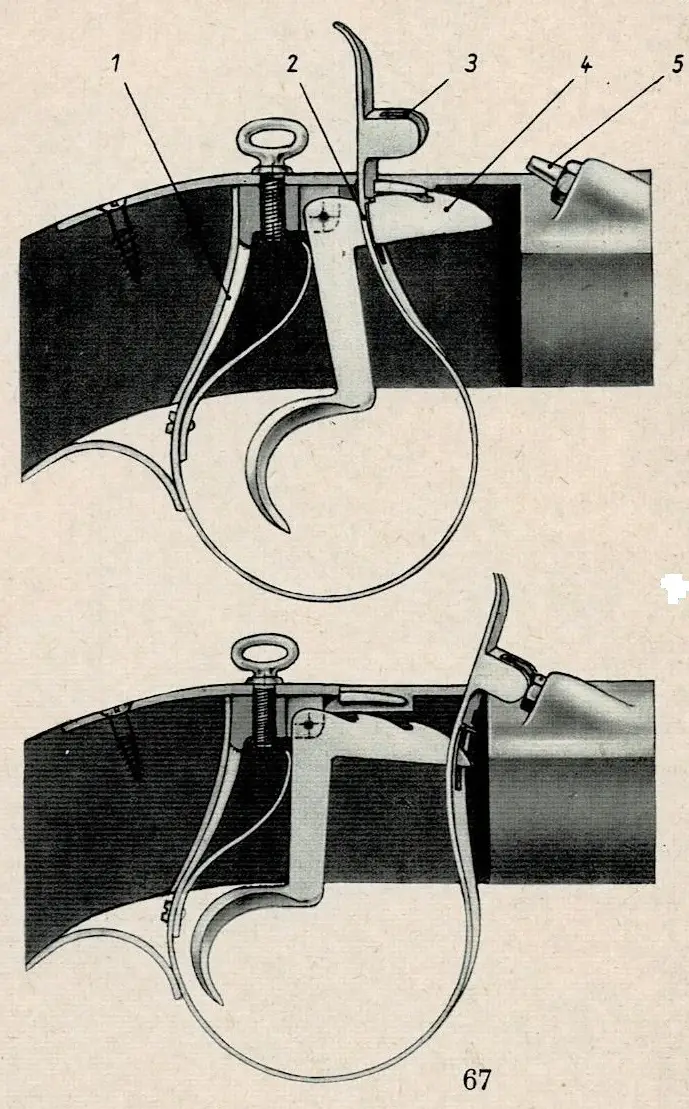
Potte Castle:
1 – mainspring, which simultaneously serves as a trigger guard; 2 – cutout on the spring for hooking the trigger; 3 – trigger; 4 – second recess (safety) of the trigger; 5 – fire tube
The design can be called simple and elegant, but... for some reason it didn’t fit. Perhaps due to the fact that such a lock was too open to the elements, and therefore required careful maintenance, and if the bracket was hit, it could fire an accidental shot.
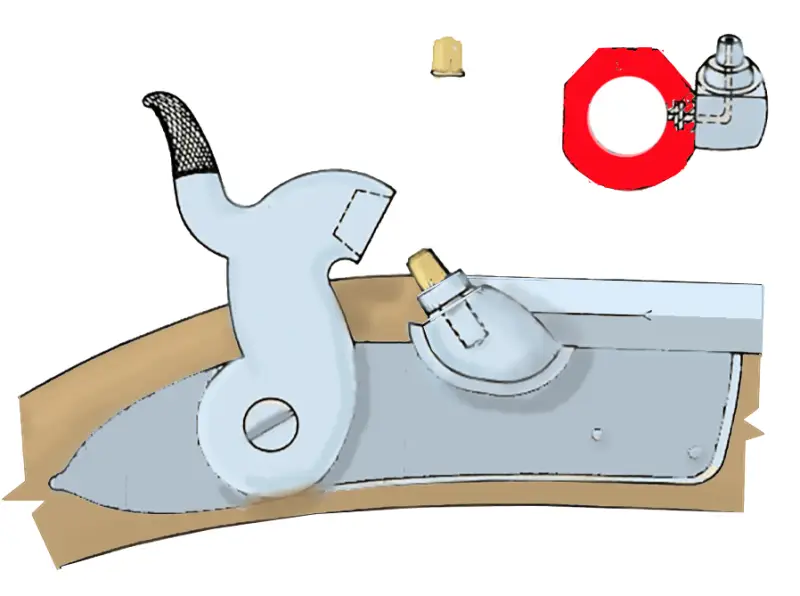
A typical capsule lock, its cut along the fire tube and the capsule.
Fig. A. Shepsa
It should be noted that Forsythe’s idea, although not immediately and not exactly as he proposed, nevertheless found its application in the English army. In 1839, rifles with cap locks were adopted by the British infantry.
Capsule pistols appeared in England even earlier, in 1825. Well, overseas the most famous capsule weapons of those years were the famous revolvers of Samuel Colt...
Very soon the form of the cap lock became, so to speak, international, except perhaps for the conversion of pistols and shotguns, which at the same time were produced in the East.
They also appeared in Russia quite early, in 1843–1845. The first percussion weapon of the Russian Imperial Army was the famous “Lüttich fitting” (produced in the Belgian city of Liege - “Luttich” is its distorted name), a fitting of the 1843 model.

“Lüttichsky fitting” 1843. Total length 123 (without bayonet) cm. Barrel length 83 cm. Caliber: 15,8 mm along the bottom of the rifling, 15,2 mm along the fields of the rifling. Penza Regional Museum of Local Lore. Photo by the author
Quite unusual guns were also equipped with cap locks at this time, including “very accurate” rifles that had a barrel with a Whitworth drill.
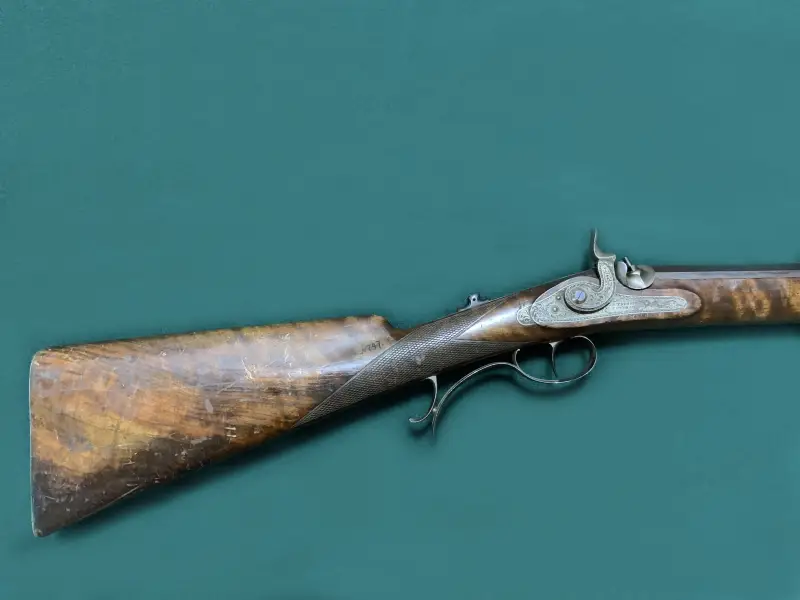
One such rifle is in the collection of the Penza Regional Museum of Local Lore, although the tip of its trigger is broken off. Total length 115 cm. Barrel length 73,4 cm. Caliber: 10 mm. The presence of a Whitworth drill in the barrel indicates that it was used for target shooting. In addition, on the neck of its butt there is a mount for a diopter sight, which is absent on the rifle. Such guns could fire both cylindrical-conical bullets and shot. On the barrel there is an inscription in English - Guss stahl. On the keyplate are S. Petersburg and R. Tschopf. Photo by the author
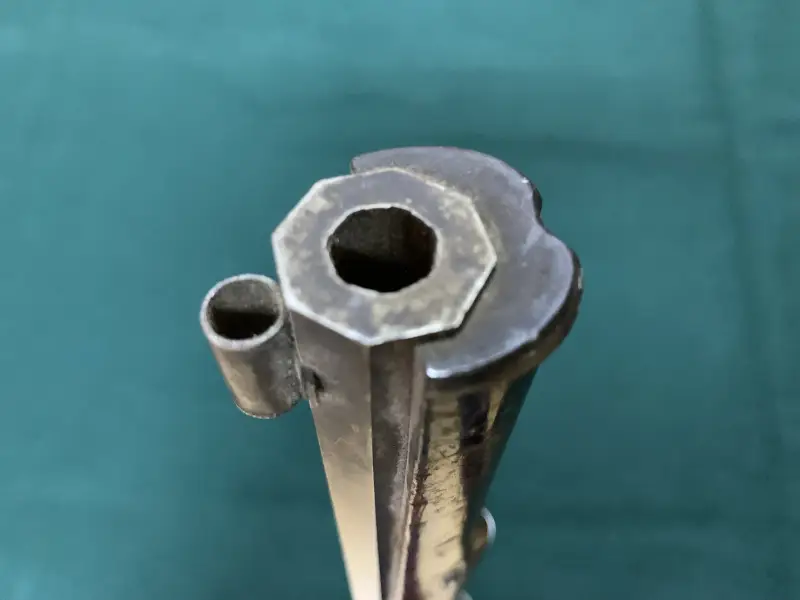
The faceted barrel of this rifle and the muzzle of its barrel with 7 rifling edges. Photo by the author
Information